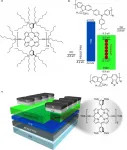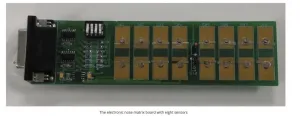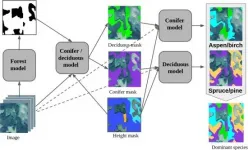(Press-News.org) BOSTON - A nationwide panel of experts has developed the first mammography guidelines for older survivors of breast cancer, providing a framework for discussions between survivors and their physicians on the pros and cons of screening in survivors' later years.
The guidelines, published online today in a paper in JAMA Oncology, recommend discontinuing routine mammograms for survivors with a life expectancy under five years; considering stopping screening for those with a 5-10-year life expectancy; and continuing mammography for those whose life expectancy is greater than 10 years. The guidelines will be complemented by printed materials to help survivors gauge their risk of cancer recurring in the breast and weigh the potential benefits and drawbacks of mammography with their health care team.
"The standard recommendation for mammography in breast cancer survivors of all ages has been annual screening. There has been little guidance on how to tailor screening for older survivors - what role life expectancy, risk of recurrence, patient preferences, or the tradeoffs associated with mammography should play," says Rachel A. Freedman, MD, MPH, of Dana-Farber Cancer Institute, the first author of the new paper. "The result is that the use of mammography for older survivors has been highly inconsistent. With the number of older women who will be diagnosed with breast cancer expected to increase in the coming years, it's important that we find ways to individualize decisions for each patient's circumstances and preferences."
To formulate the new guidelines, Freedman recruited an 18-member panel of patients in addition to breast cancer primary care, geriatrics, radiology, survivorship, and nursing experts from around the country to review the scientific literature on the risk of in-breast cancer among older breast cancer survivors, taking into account the subtype of cancer, the treatment patients received, their age, and health status. The group conducted a parallel review of research on the benefits and downsides of mammography. (Designed to detect breast cancer at an early stage, mammograms sometimes uncover growths that turn out not be cancerous, or small, slow-growing tumors that won't have an impact on an older woman's life expectancy. The detection of such growths often entails further stress and anxiety, tests, and treatment.)
Reassuringly, the literature review confirmed that most older breast cancer survivors had a low risk for breast cancer in either breast - particularly for those who had been treated with hormone-blocking therapy for hormone receptor-positive tumors. The panel estimated older survivors' risk of developing cancer in the breast over a 10-year period and organized their results by cancer type and treatment.
The review of mammography studies found that although the benefits of screening in older women are not well defined, research suggests mammography offers little to modest clinical benefit for many older women. The main downsides of mammography were false-positives (detection of growths that appear cancerous but turn out not to be), anxiety associated with diagnostic testing, and overtreatment.
Combining the results of these reviews, the panel formulated a series of mammography guidelines for survivors of breast cancer. The guidelines were considered by a group of clinicians and patient advocates and by five clinician focus groups, resulting in several revisions. After further review by the International Society for Geriatric Oncology, the guidelines were refined and finalized.
Because of the low risk that older survivors will develop a cancer in their breast, the lengthy time needed for the small benefits of mammography to be realized, and the persistence of the negative effects of mammography, the new guidelines recommend discontinuing mammography for breast cancer survivors age 75 or older whose life expectancy is under five years. This holds even for those with a history of higher-risk tumors such as triple-negative or ERBB2-positive. (Life expectancy is estimated by factors such as an individual's medical history, their degree of functional independence, whether they smoke cigarettes, had a fall in the previous year, and whether they were recently hospitalized.) The guidelines call for consideration of stopping mammography when life expectancy is five to 10 years and continuing annual or biennial mammography when life expectancy exceeds 10 years. For women age 85 and older, whose life expectancy is often under five years, the guidelines recommend ceasing mammography unless an individual is in extraordinary health and has a strong preference to continue testing.
Freedman emphasizes that the new guidelines are not prescriptive but should serve as a starting point for older survivors of breast cancer in conversations with their physician. "The purpose of the guidelines is to offer clinicians support for having these conversations with patients and to make a shared, individualized decision for each woman," she says.
INFORMATION:
The senior authors of the paper are Nancy L. Keating, MD, MPH, of Brigham and Women's Hospital, and Mara A. Schonberg, MD, MPH, of Beth Israel Deaconess Medical Center. Co-authors are: Eric P. Winer, MD, Haley Gagnon, Adriana Perilla-Glen, MBA, Nancy U. Lin, MD, and Anna C. Revette, PhD, of Dana-Farber; Barbara K. LeStage, MHP, of Dana-Farber and the Alliance for Clinical Trials in Oncology; Christina A. Minami, MD, MFA, MS, of Brigham and Women's Hospital; Monica Morrow, MD, and Stuart M. Lichtman, MD, of Memorial Sloan Kettering Cancer Center; Alexander K. Smith, MD, MS, MPH, and Louise C. Walter, MD, of Veterans Affairs Health Care System, San Francisco, Calif.; Mina S. Sedrak, MD, MS, of City of Hope; Hans Wildiers, MD, of University Hospitals, Leuven, Belgium; Tanya M. Wildes, MD, MDSI, of Washington University School of Medicine; Kah Poh Loh, MBBCh, BAO, of University of Rochester School of Medicine and Dentistry; Etienne G. C. Brain, MD, PhD, of Institut Curie, Saint-Cloud, France; Pamela S. Ganschow, MD, of Rush University Medical College and Cook County Health; Kelly K. Hunt, MD, of The University of Texas MD Anderson Cancer Center; Deborah K. Mayer, PhD, RN, AOCN, of University of North Carolina at Chapel Hill; Kathryn J. Ruddy, MD, MPH, of the Mayo Clinic; and Reshma Jagsi, MD, DPhil, of the University of Michigan; Beverly Canin, of the Cancer and Aging Research Group.
The study was supported by the National Cancer Institute (grants R21CA227615-01A1 and P30 CA00874.8); Susan G. Komen (CCRCR18552788); the American Cancer Society (MRSG-14-240-01-CPPB); and the National Institute on Aging (P30 AG044281.
About Dana-Farber Cancer Institute
Dana-Farber Cancer Institute is one of the world's leading centers of cancer research and treatment. Dana-Farber's mission is to reduce the burden of cancer through scientific inquiry, clinical care, education, community engagement, and advocacy. We provide the latest treatments in cancer for adults through Dana-Farber/Brigham and Women's Cancer Center and for children through Dana-Farber/Boston Children's Cancer and Blood Disorders Center. Dana-Farber is the only hospital nationwide with a top 10 U.S. News & World Report Best Cancer Hospital ranking in both adult and pediatric care.
As a global leader in oncology, Dana-Farber is dedicated to a unique and equal balance between cancer research and care, translating the results of discovery into new treatments for patients locally and around the world, offering more than 1,100 clinical trials.
Science is society's best method for understanding the world. Yet many scientists are unhappy with the way it works, and there are growing concerns that there is something "broken" in current scientific practice. Many of the rules and procedures that are meant to promote innovative research are little more than historical precedents with little reason to suppose they encourage efficient or reliable discoveries. Worse, they can have perverse side-effects that harm both science and scientists. A well-known example is the general preference for positive over negative results, which creates a "publication bias" that gives the false ...
CLEVELAND - Cleveland Clinic researchers have described for the first time how Zika virus (ZIKV) causes one of the most common birth defects associated with prenatal infection, called brain calcification, according to new study findings published in Nature Microbiology.
The findings may reveal novel strategies to prevent prenatal ZIKV brain calcification and offer important insights into how calcifications form in other congenital infections.
"Brain calcification has been linked to several developmental defects in infants, including motor disorders, cognitive disability, eye abnormalities, hearing deficits and seizures, so it's important to better understand the mechanisms of how they develop," said Jae Jung, ...
Advances in DNA sequencing have uncovered a rare syndrome which is caused by variations in the gene SATB1.
The study, co-authored by academics from Oxford Brookes University (UK), University of Lausanne (Switzerland), Radboud University (The Netherlands), University of Oxford (UK), University of Manchester (UK) and led by Max Planck Institute for Psycholinguistics (The Netherlands), discovered three classes of mutations within the gene SATB1, resulting in three variations of a neurodevelopmental disorder with varying symptoms ranging from epilepsy to muscle tone abnormalities.
Recognition of disorder will increase understanding and diagnosis
An international team of geneticists and clinicians from 12 countries identified 42 patients with mutations in the gene ...
People with sleep disorders commonly have a misperception about their actual sleep behaviour. A research group led by Karin Trimmel and Stefan Seidel from MedUni Vienna's Department of Neurology (Outpatient Clinic for Sleep Disorders and Sleep-Related Disorders) analysed polysomnography results to identify the types of sleep disorder that are associated with a discrepancy between self-reported and objective sleep parameters and whether there are any factors that influence this. The main finding: irrespective of age, gender or screening setting, insomnia patients are most likely to underestimate how long they sleep. The study has been published in the highly regarded Journal of Clinical Sleep Medicine.
Patients' misperceptions about the actual time that they sleep is a well-known ...
The ability to manipulate near-infrared (NIR) radiation has the potential to enable a plethora of technologies not only for the biomedical sector (where the semitransparency of human tissue is a clear advantage) but also for security (e.g. biometrics) and ICT (information and communication technology), with the most obvious application being to (nearly or in)visible light communications (VLCs) and related ramifications, including the imminent Internet of Things (IoT) revolution. Compared with inorganic semiconductors, organic NIR sources offer cheap fabrication over large areas, mechanical flexibility, conformability, ...
Mass spectrometers are widely used to analyze highly complex chemical and biological mixtures. Skoltech scientists have developed a new version of a mass spectrometer that uses rotation frequencies of ionized molecules in strong magnetic fields to measure masses with higher accuracy (FT ICR). The team has designed an ion trap that ensures the utmost resolving power in ultra-strong magnetic fields. The research was published in the journal Analytical Chemistry.
The ion trap is shaped like a cylinder made up of electrodes, with electric and magnetic fields generated inside. The exact masses of the test sample's ions can be determined from their rotation frequencies. The electrodes must create a harmonized field of a particular shape ...
Skoltech researchers and their colleagues from Russia and Germany have designed an on-chip printed 'electronic nose' that serves as a proof of concept for low-cost and sensitive devices to be used in portable electronics and healthcare. The paper was published in the journal ACS Applied Materials Interfaces.
The rapidly growing fields of the Internet of Things (IoT) and advanced medical diagnostics require small, cost-effective, low-powered yet reasonably sensitive, and selective gas-analytical systems like so-called 'electronic noses.' These ...
A genetic engineering method makes it possible to observe how woody cell walls are built in plants. The new research in wood formation, conducted by the University of Copenhagen and others, opens up the possibility of developing sturdier construction materials and perhaps more climate efficient trees.
The ability of certain tree species to grow taller than 100 meters is due to complex biological engineering. Besides needing the right amounts of water and light to do so, this incredible ability is also a result of cell walls built sturdily enough to keep a tree both upright and able to withstand the tremendous pressure created as water is sucked up from its roots and into its leaves.
This ability is made possible by what are known as the secondary cell ...
Skoltech scientists have developed an algorithm that can identify various tree species in satellite images. Their research was published in the IEEE Journal of Selected Topics in Applied Earth Observations and Remote Sensing.
Identifying tree species is essential for efficient forest management and monitoring. Satellite imagery is an easier and cheaper way to deal with this task than other approaches that require ground observations of vast and remote areas.
Researchers from the Skoltech Center for Computational and Data-Intensive Science and Engineering (CDISE) and Skoltech Space Center used a neural network to automate dominant tree species' identification in high and medium resolution images. A hierarchical classification model and additional data, such as vegetation height, helped ...
People with combined vision and hearing loss are nearly four times more likely to experience depression and more than three times more likely to suffer chronic anxiety, according to a new study published in the journal Frontiers in Psychology and led by Anglia Ruskin University (ARU).
Researchers analysed a health survey of 23,089 adults in Spain and found that while people suffering either vision or hearing loss both were more likely to report depression as those that were not, that risk increased to 3.85 times higher when respondents reported problems with both senses combined.
The study also found people with combined vision and hearing loss were 3.38 times more likely than the general population to report chronic anxiety.
It is understood to be the first study looking at ...






